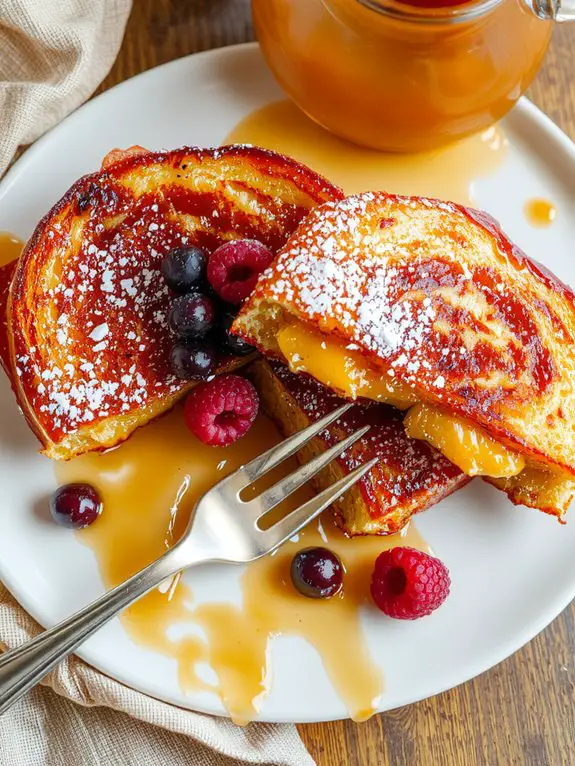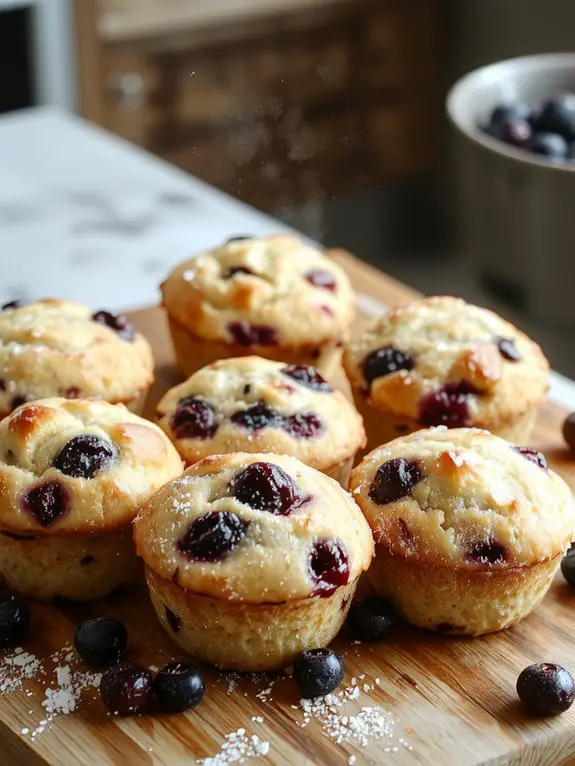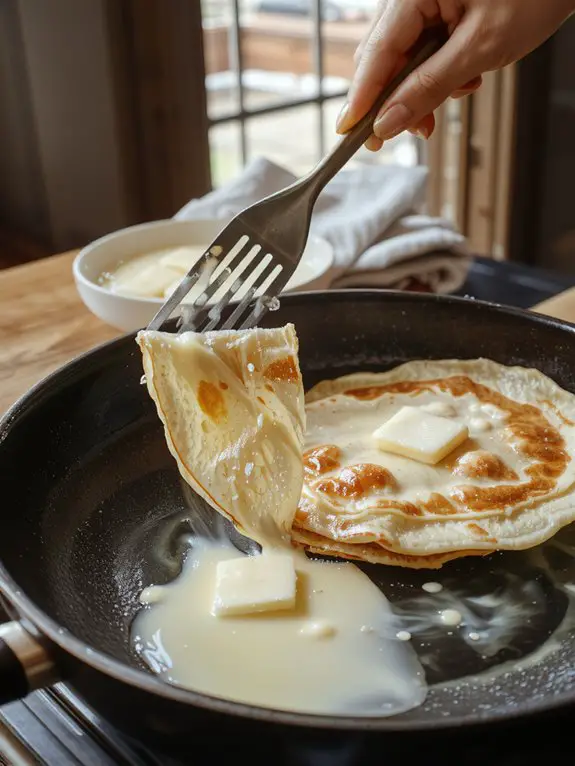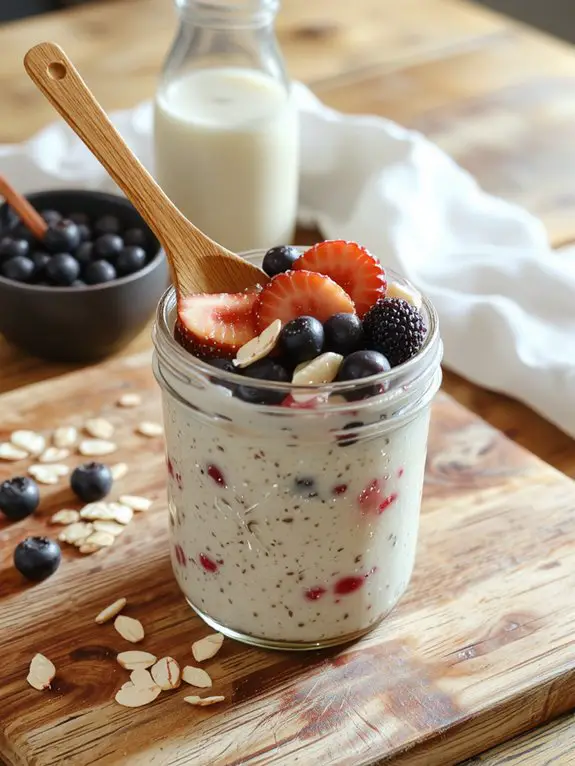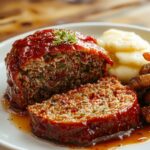I’ve spent years perfecting my French toast technique, and I can tell you that most people make the same critical mistake that turns what should be a custardy, golden masterpiece into soggy disappointment. The secret isn’t in the bread you choose or even the custard mixture—though both matter more than you’d think. It’s something far simpler that’ll transform your weekend breakfast game completely.
Recipe
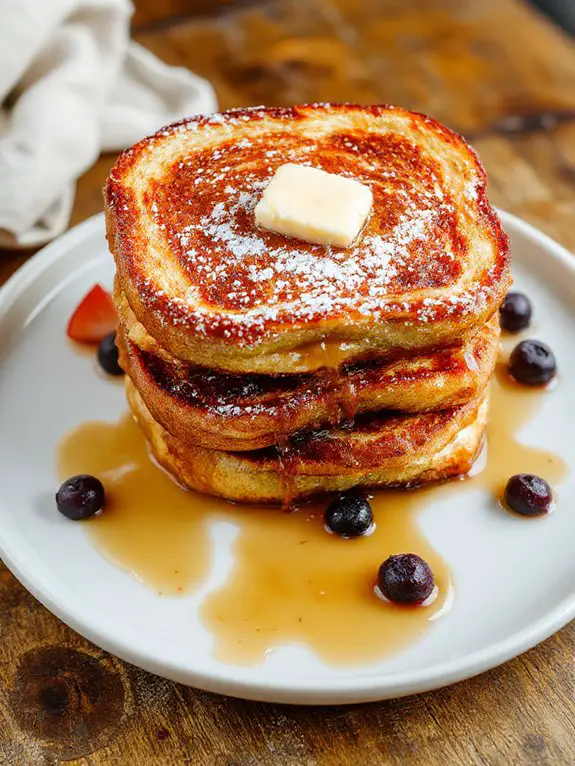
I can vouch for this French toast recipe and tell you with 100% surety that it will become your weekend breakfast obsession—crispy, golden edges giving way to a custard-like center that’s pure heaven on a plate. What makes this version absolutely irresistible is the secret blend of vanilla, cinnamon, and just a hint of nutmeg in the egg mixture, plus using thick-cut brioche or challah bread that soaks up all those gorgeous flavors without falling apart.
I’ve been perfecting this recipe for years, testing it on everyone from picky kids to discerning brunch guests, and the reaction is always the same: complete silence followed by requests for seconds.
The moment it hits the hot, buttered pan, your kitchen fills with that warm, cinnamon-vanilla aroma that makes everyone gravitate toward the stove, and when you take that first bite, you get this amazing contrast of textures—that satisfying crunch from the caramelized exterior and the soft, custardy interior that practically melts in your mouth.
Trust me, once you nail the technique of getting the bread perfectly soaked but not soggy, and achieving that beautiful golden-brown crust, you’ll never want to order French toast at a restaurant again because yours will be infinitely better.
Ingredients
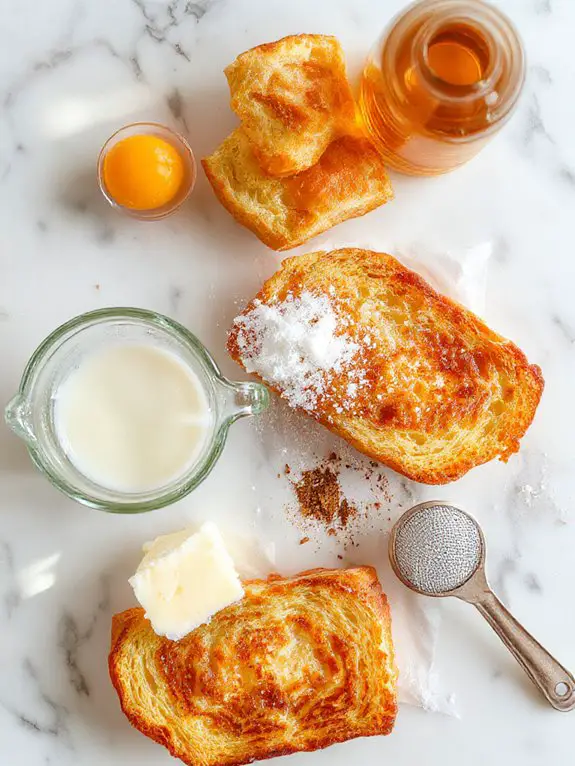
The secret to restaurant-quality French toast isn’t fancy technique—it’s choosing the right ingredients and knowing how to use them like a pro. Think of this as your insider’s guide to creating that perfect balance of crispy edges and custardy center that makes people close their eyes on the first bite.
For the Toast:
- Thick-cut brioche or challah bread – Day-old is actually BETTER here! Fresh bread gets soggy, but slightly stale bread soaks up the custard perfectly without falling apart. No brioche? Texas toast or even thick sourdough works beautifully.
- Large eggs – The foundation of your custard base. Room temperature eggs blend smoother, but cold ones work fine if you whisk vigorously.
- Heavy cream – This is what makes French toast luxurious instead of just “eggy bread.” Half-and-half works in a pinch, but don’t go lower than whole milk or you’ll lose that rich, creamy texture.
- Whole milk – Mixed with the cream for the perfect consistency that coats the bread without being too thick.
- Pure vanilla extract – Skip the imitation stuff here! Real vanilla makes a noticeable difference when there are so few ingredients.
- Ground cinnamon – A generous pinch adds warmth without overpowering. Fresh-ground cinnamon is a game-changer if you have it.
- Pinch of salt – Non-negotiable! It enhances every other flavor and prevents that flat, one-dimensional taste.
- Granulated sugar – Just a tablespoon sweetens the custard and helps with browning.
For Cooking:
- Butter – Real butter for flavor, but have some neutral oil on standby. Butter alone can burn, so a little oil helps it go the distance.
- Maple syrup – The real stuff, not pancake syrup! This is your moment to splurge on pure maple syrup.
- Powdered sugar for dusting – Makes even a Tuesday morning feel special and covers any imperfections beautifully.
How to Make the Best Classic Brioche French Toast
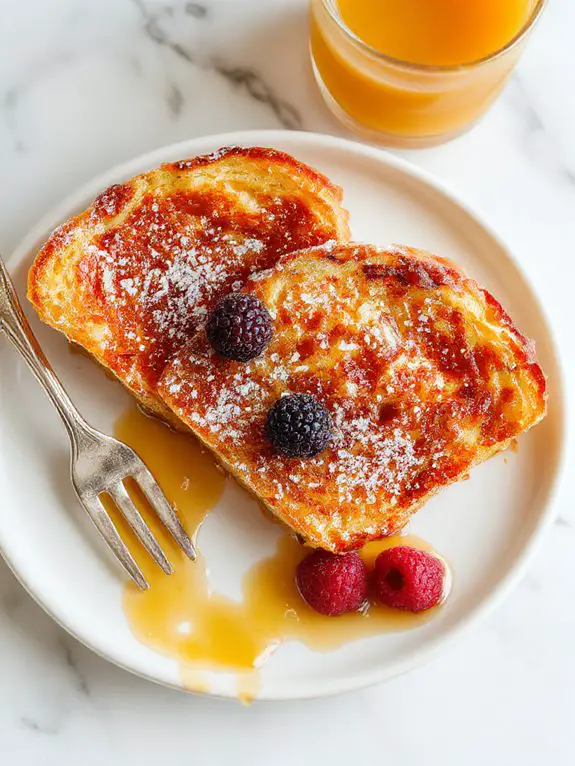
Slice your brioche into thick, luxurious pieces—about ¾ to 1 inch thick.
Think generous doorstop slices rather than dainty sandwich bread. Thick slices are your secret weapon here because they’ll soak up the custard without falling apart, creating that perfect contrast between crispy exterior and custardy center. If your slices are too thin, they’ll turn soggy and tear when you flip them.
Let the sliced brioche sit out for 15-20 minutes to slightly stale, or use day-old bread.
Fresh brioche is wonderful for eating, but slightly stale bread is your friend for French toast. This brief drying time helps the bread hold its structure when it meets the custard mixture. If you’re using fresh brioche, you can even pop the slices in a 200°F oven for 5 minutes to help them along—just don’t let them brown.
Whisk together eggs, milk, cream, vanilla, and a pinch of salt in a shallow dish.
Use a wide, shallow bowl or pie dish that can easily fit your bread slices. The combination of milk and cream creates the perfect richness—all milk can be too thin, while all cream might be too heavy.
Whisk until completely smooth with no streaky egg whites visible, which guarantees every bite has consistent flavor.
Add a tablespoon of sugar and a dash of cinnamon to your custard base.
The sugar helps with browning and adds subtle sweetness, while cinnamon brings warmth without overpowering the delicate brioche flavor. Don’t go overboard—brioche is already slightly sweet, so you want to enhance, not mask, its buttery richness.
Heat butter in a large skillet or griddle over medium-low heat.
Medium-low is essential here—resist the urge to crank up the heat. Higher temperatures will burn the outside before the custard center has time to set. Use enough butter to coat the pan generously; this isn’t the time to be shy. The butter should sizzle gently when it hits the pan, not violently bubble.
Dip each brioche slice in the custard mixture for 10-15 seconds per side.
Don’t just quickly swipe the bread through—let it have a proper soak, but don’t let it sit so long that it becomes waterlogged and fragile. You want the custard to penetrate but still maintain the bread’s integrity.
Gently lift each slice and let excess custard drip off before transferring to the pan.
Cook for 2-3 minutes on the first side until golden brown and set.
Watch for that beautiful golden color and listen for a gentle sizzle—not aggressive bubbling. The edges should look slightly set, and when you gently lift a corner with your spatula, you should see an even golden-brown surface. If it’s browning too quickly, lower your heat immediately.
Flip carefully and cook for another 2-3 minutes on the second side.
Use a wide spatula and flip with confidence—hesitant, multiple attempts can break your beautiful toast. The second side usually cooks faster than the first, so keep a close eye. You’re looking for matching golden-brown color and a slight spring-back when gently pressed in the center.
Transfer to a warm oven (200°F) if making multiple batches.
Place finished pieces on a baking sheet in a low oven to keep them warm and prevent sogginess while you finish the rest. Don’t stack them—lay them in a single layer so they stay crispy. This trick guarantees everyone gets hot French toast at the same time instead of some people eating while others wait.
Serve immediately with a light dusting of powdered sugar and pure maple syrup.
Brioche French toast is rich enough that it doesn’t need heavy toppings—let the bread be the star. A gentle snowfall of powdered sugar and good-quality maple syrup is perfect.
Fresh berries add a lovely tart contrast if you want something extra, but honestly, this French toast is magnificent on its own.
Chef Tips
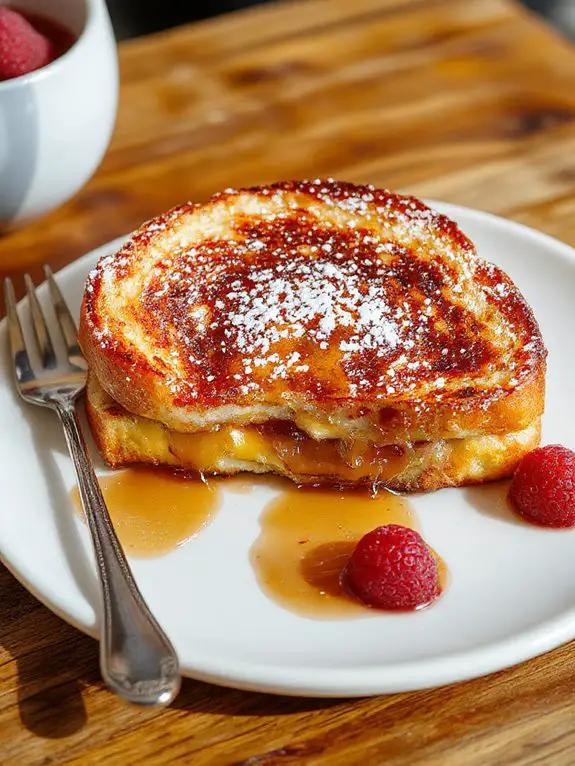
While mastering basic French toast technique gets you great results, these professional secrets will elevate your game to restaurant quality.
I’ve learned that controlling moisture is everything—if you’re dealing with particularly fresh bread that won’t stale quickly enough, lightly toast the slices in a dry skillet for 30 seconds per side before soaking.
Sharp knife skills guarantee uniform thickness, while thoughtful plating techniques create visual impact.
Nutrition
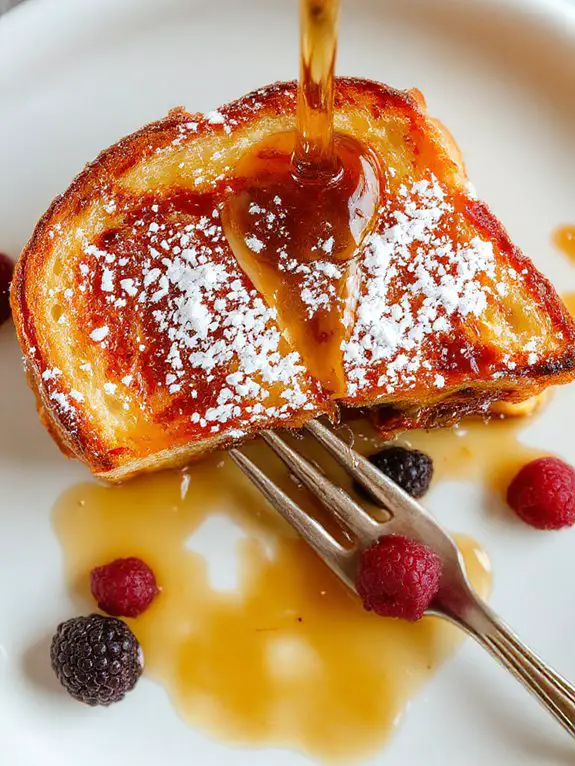
French toast is a beloved breakfast dish that combines simple ingredients to create a satisfying meal. Understanding its nutritional content can help you make informed choices about portion sizes and ingredients.
| Nutrient | Per Serving (2 slices) | % Daily Value |
|---|---|---|
| Calories | 356 | 18% |
| Total Fat | 10.7g | 14% |
| Saturated Fat | 3.8g | 19% |
| Cholesterol | 117mg | 39% |
| Sodium | 513mg | 22% |
| Total Carbohydrates | 56.3g | 20% |
| Dietary Fiber | 2.1g | 8% |
| Total Sugars | 14.2g | – |
| Protein | 10.4g | 21% |
| Vitamin A | 138mcg | 15% |
| Calcium | 151mg | 12% |
| Iron | 3.6mg | 20% |
| Potassium | 177mg | 4% |
What You’ll Love About This Recipe
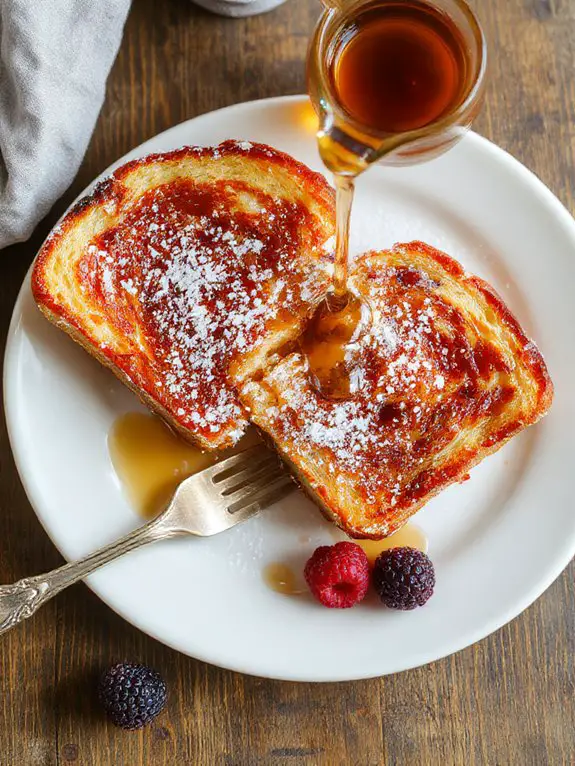
This French toast recipe will quickly become your go-to breakfast favorite, combining simple ingredients with foolproof techniques that work every time. Whether you’re cooking for a lazy Sunday morning or trying to impress weekend guests, this recipe delivers that perfect balance of crispy edges and custardy centers that makes French toast so irresistible.
Quick and Easy Preparation – With just a few pantry staples and about 15 minutes, you’ll have golden, restaurant-quality French toast ready to serve. This makes it perfect for busy mornings or spontaneous breakfast cravings.
Foolproof Results Every Time – The simple custard base and clear cooking instructions mean you’ll get consistently delicious results. This is true even if you’re new to making French toast or cooking breakfast for a crowd.
Endless Customization Options – This versatile base recipe works beautifully with different breads, spices, and toppings. You can easily adapt it to suit your family’s preferences or whatever ingredients you have on hand.
Recipe Card
This classic French toast recipe transforms ordinary bread into a golden, custardy breakfast treat that’s crispy on the outside and tender on the inside. Perfect for weekend mornings or special occasions, this simple yet delicious dish requires just a few pantry staples and delivers restaurant-quality results every time.
Ingredients:
- 8 thick slices of bread (brioche, challah, or Texas toast work best)
- 4 large eggs
- 1/2 cup whole milk
- 2 tablespoons heavy cream
- 1 tablespoon granulated sugar
- 1 teaspoon vanilla extract
- 1/2 teaspoon ground cinnamon
- 1/4 teaspoon salt
- 2-3 tablespoons butter for cooking
- Powdered sugar for dusting
- Maple syrup for serving
Instructions:
- In a shallow dish, whisk together eggs, milk, heavy cream, sugar, vanilla extract, cinnamon, and salt until well combined.
- Heat a large skillet or griddle over medium heat and add 1 tablespoon of butter.
- Dip each slice of bread into the egg mixture, allowing it to soak for 10-15 seconds on each side.
- Place soaked bread slices in the heated skillet and cook for 2-3 minutes per side until golden brown and crispy.
- Add more butter to the pan as needed for remaining slices.
- Serve immediately, dusted with powdered sugar and drizzled with maple syrup.
Notes:
Day-old bread works best as it absorbs the custard mixture without falling apart.
Avoid over-soaking thin bread slices to prevent them from becoming soggy. Keep cooked French toast warm in a 200°F oven if making multiple batches.
Equipment:
Large skillet or griddle, shallow dish for dipping, whisk, spatula
Prep time: 10 minutes
Cooking time: 15 minutes
Cuisine: French-American
Serving: 4 servings

